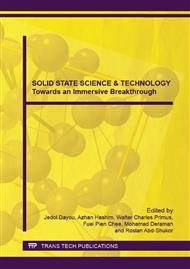p.96
p.103
p.108
p.113
p.119
p.125
p.131
p.137
p.145
Tensile and Dielectric Properties of Calcium Copper Titanate Filler in Epoxy Composites
Abstract:
Polymer-ceramic composites have been pursued as the most promising dielectric materials for embedded capacitors in the organic package. In this study, ceramic fillers such as Calcium Copper Titanate (CCTO) was used to produce epoxy thin film composites for the purpose to replace capacitor made of ceramic materials. Spin coating technique was used to produce epoxy thin film composites. The effect of fillers loading on tensile and dielectric properties of the epoxy thin film composites were determined. Results showed that epoxy thin film with 20 vol% filler loading showed good dielectric properties. However, an increase of the fillers content caused reduction in the tensile properties due to filler agglomeration and voids. Dielectric constants and dielectric losses of epoxy/inorganic composite films generally increase with addition of filler.
Info:
Periodical:
Pages:
119-124
Citation:
Online since:
June 2015
Authors:
Price:
Сopyright:
© 2015 Trans Tech Publications Ltd. All Rights Reserved
Share:
Citation:


